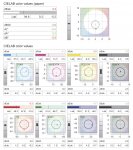Vernon Roberts
Active member
Hello,
I'm currently evaluating our solid ink LABs. I have received a certificate of analysis and compliance from our ink manufacturer that states it's in compliance with ISO-2846-1 as directed in ISO 12647-2.
Right now, when referencing GRACoL 2006 and averaging 10 it8s, measured with an X-Rite iSis in M0 mode, yellow and paper white are out of spec. My pressroom manager says they can't run density any higher. My theory is the paper white is affecting yellow. I can convert my paper white to the standard in Color Toolbox (what I'm working in), that does what I guess is a simulation of CMYK and RGB solids. All deltas improve when I do this. My theory is optical brighteners in the paper are making the paper bluer, and thus affecting yellow the most, because of it's transparency.
I'm looking to upgrade into a complete M1 workflow, but right now everything is too new and I don't have RIP support yet. I'm asking for opinions on what else could be the problem or if it is the paper whiteness, what can I do? Adjust my standard and live with it? What about proofs? Thanks

I'm currently evaluating our solid ink LABs. I have received a certificate of analysis and compliance from our ink manufacturer that states it's in compliance with ISO-2846-1 as directed in ISO 12647-2.
Right now, when referencing GRACoL 2006 and averaging 10 it8s, measured with an X-Rite iSis in M0 mode, yellow and paper white are out of spec. My pressroom manager says they can't run density any higher. My theory is the paper white is affecting yellow. I can convert my paper white to the standard in Color Toolbox (what I'm working in), that does what I guess is a simulation of CMYK and RGB solids. All deltas improve when I do this. My theory is optical brighteners in the paper are making the paper bluer, and thus affecting yellow the most, because of it's transparency.
I'm looking to upgrade into a complete M1 workflow, but right now everything is too new and I don't have RIP support yet. I'm asking for opinions on what else could be the problem or if it is the paper whiteness, what can I do? Adjust my standard and live with it? What about proofs? Thanks

Last edited:














